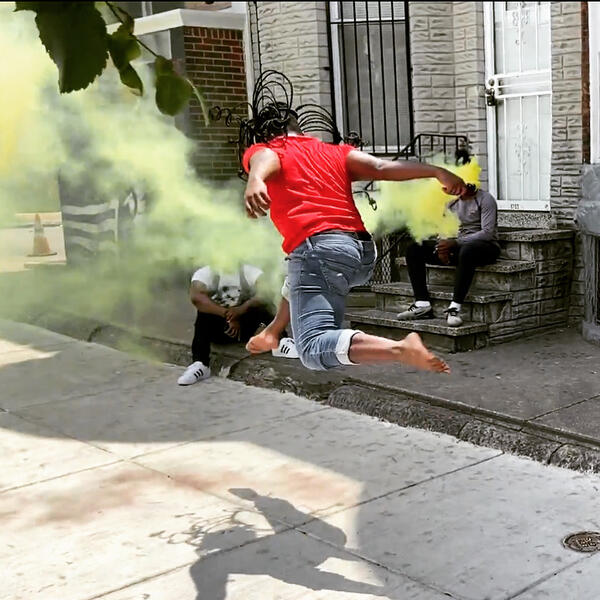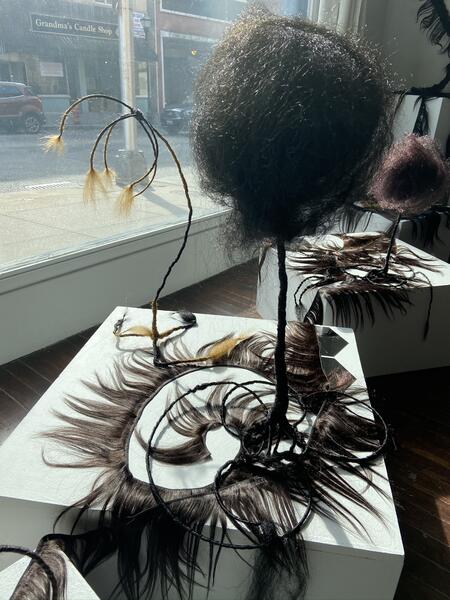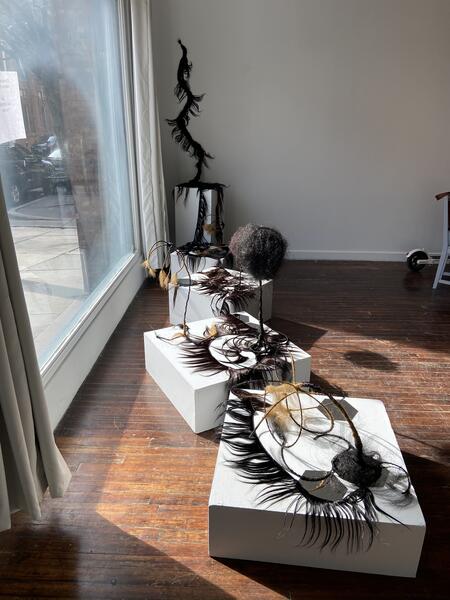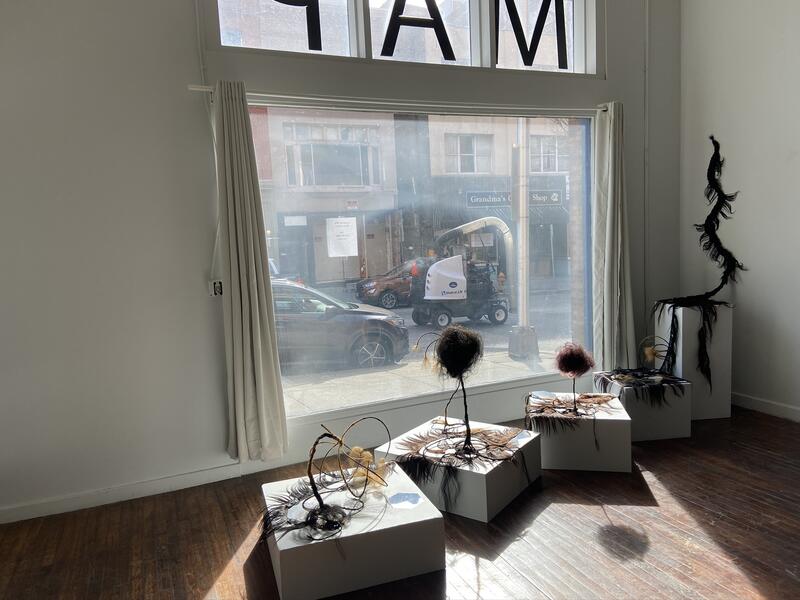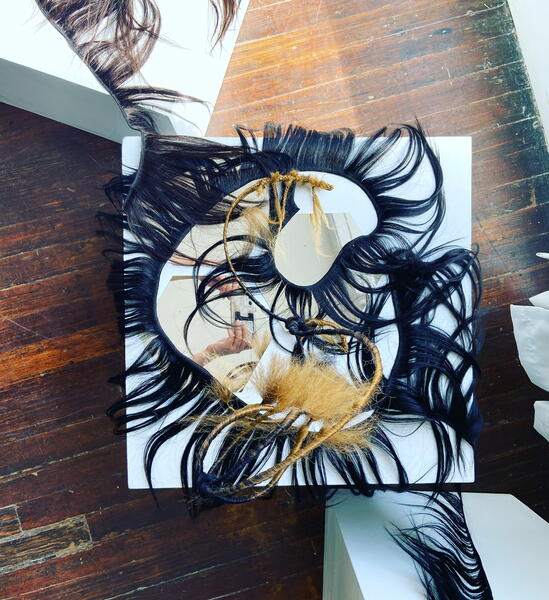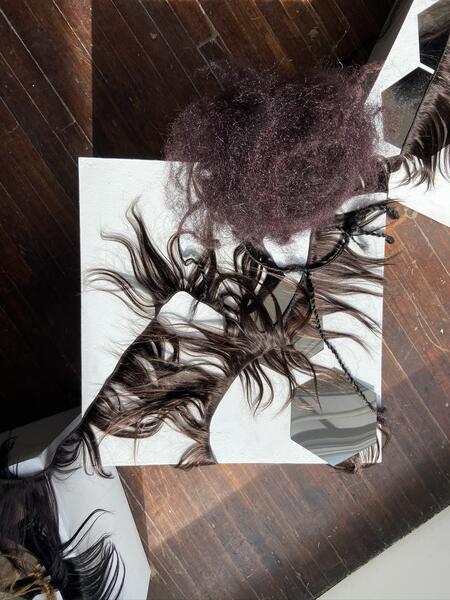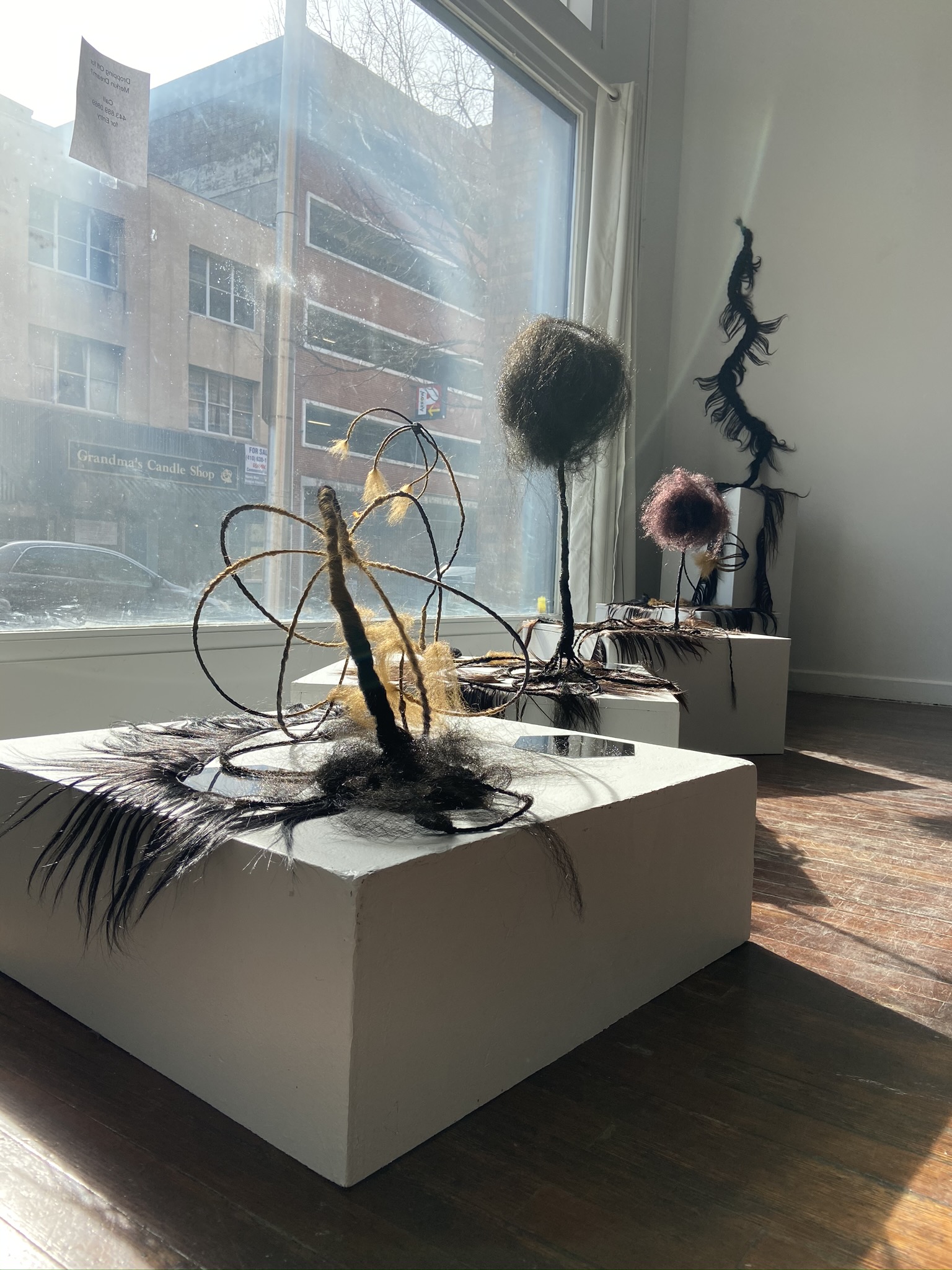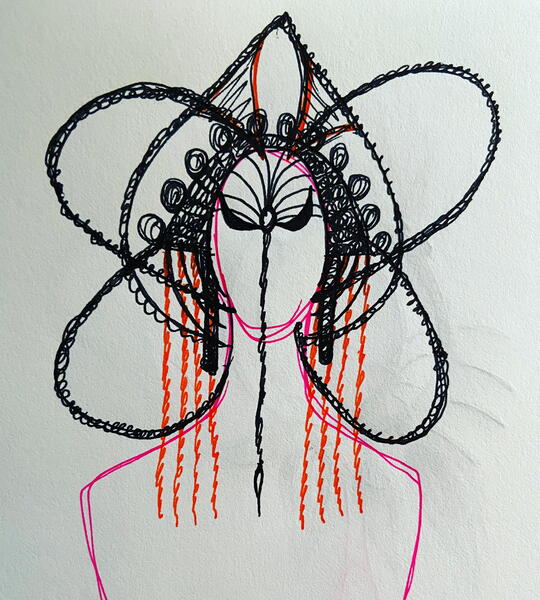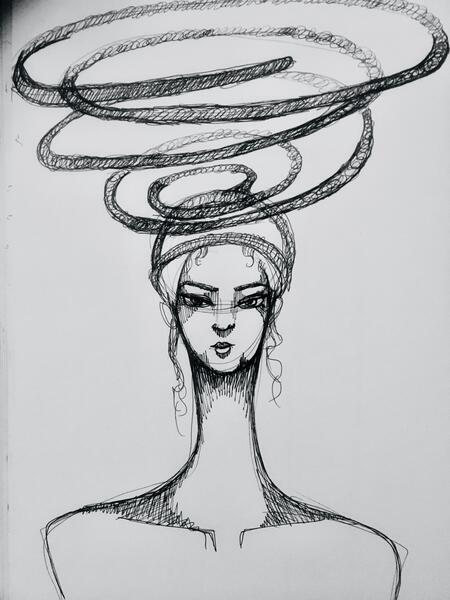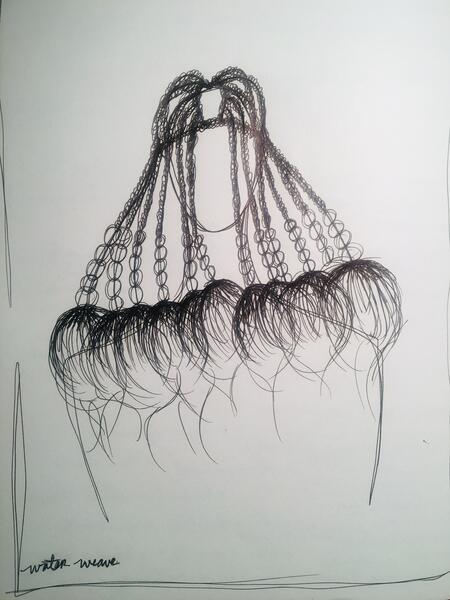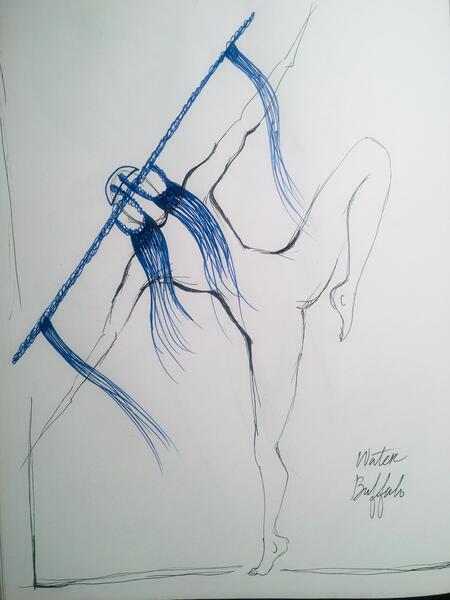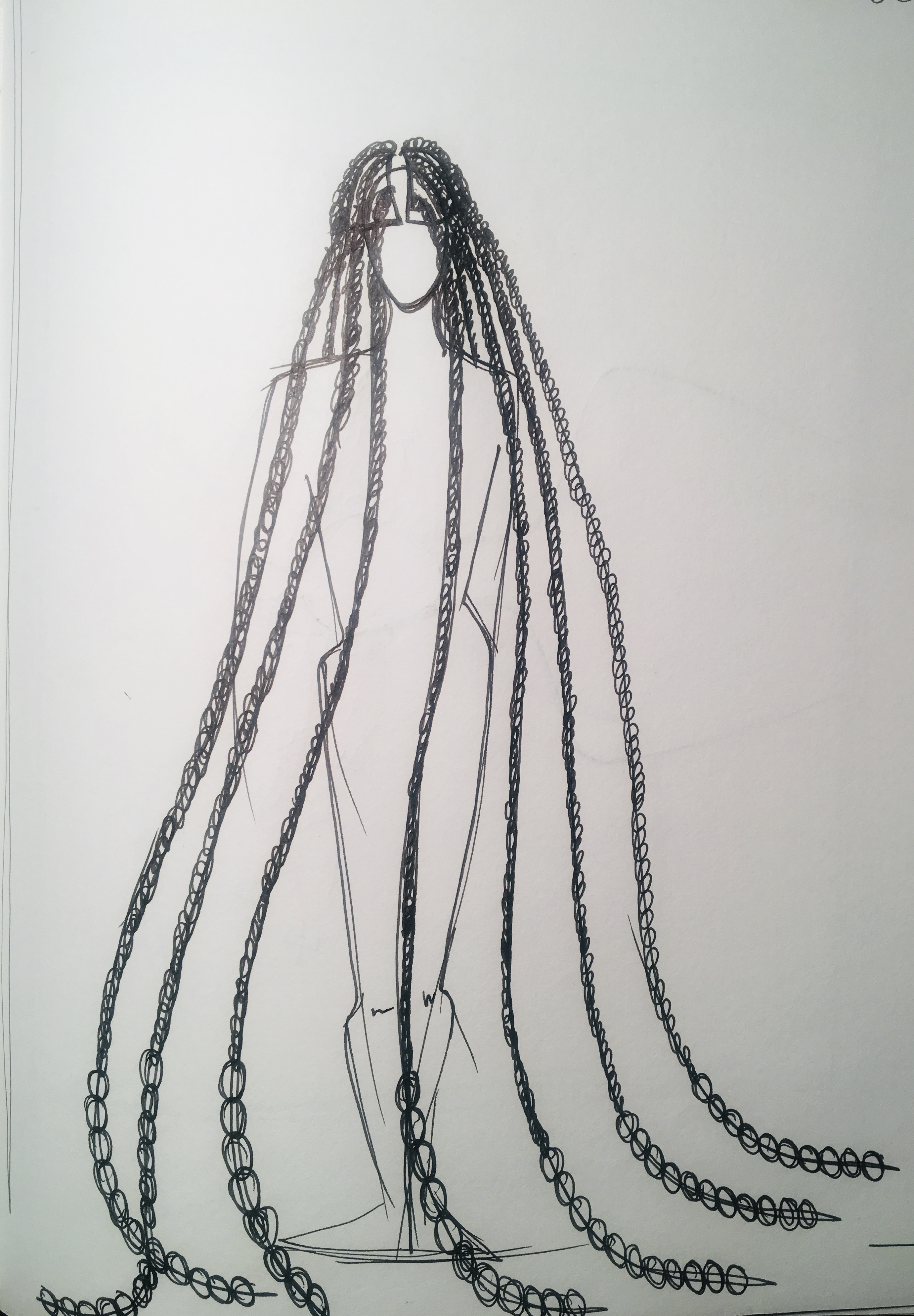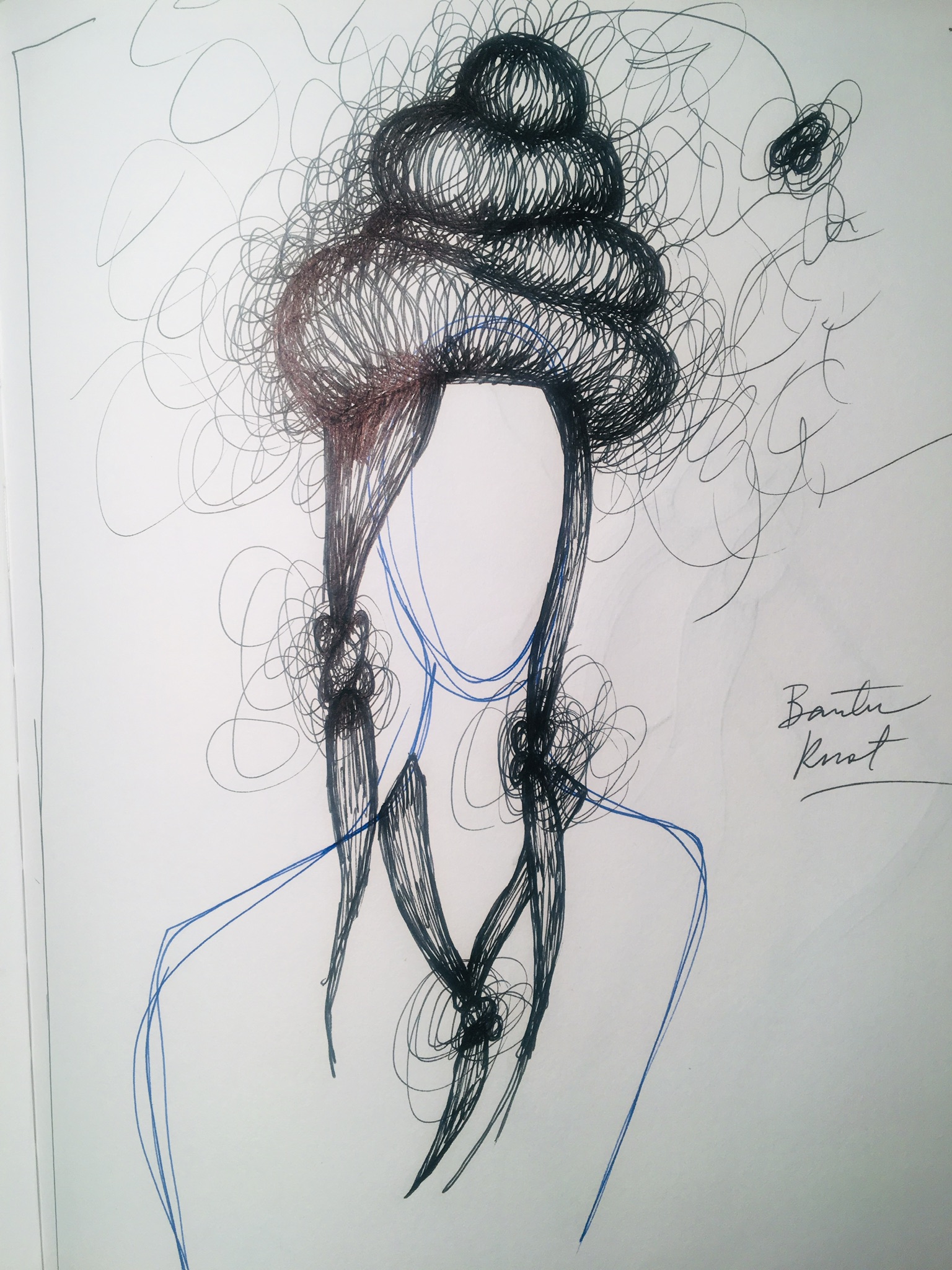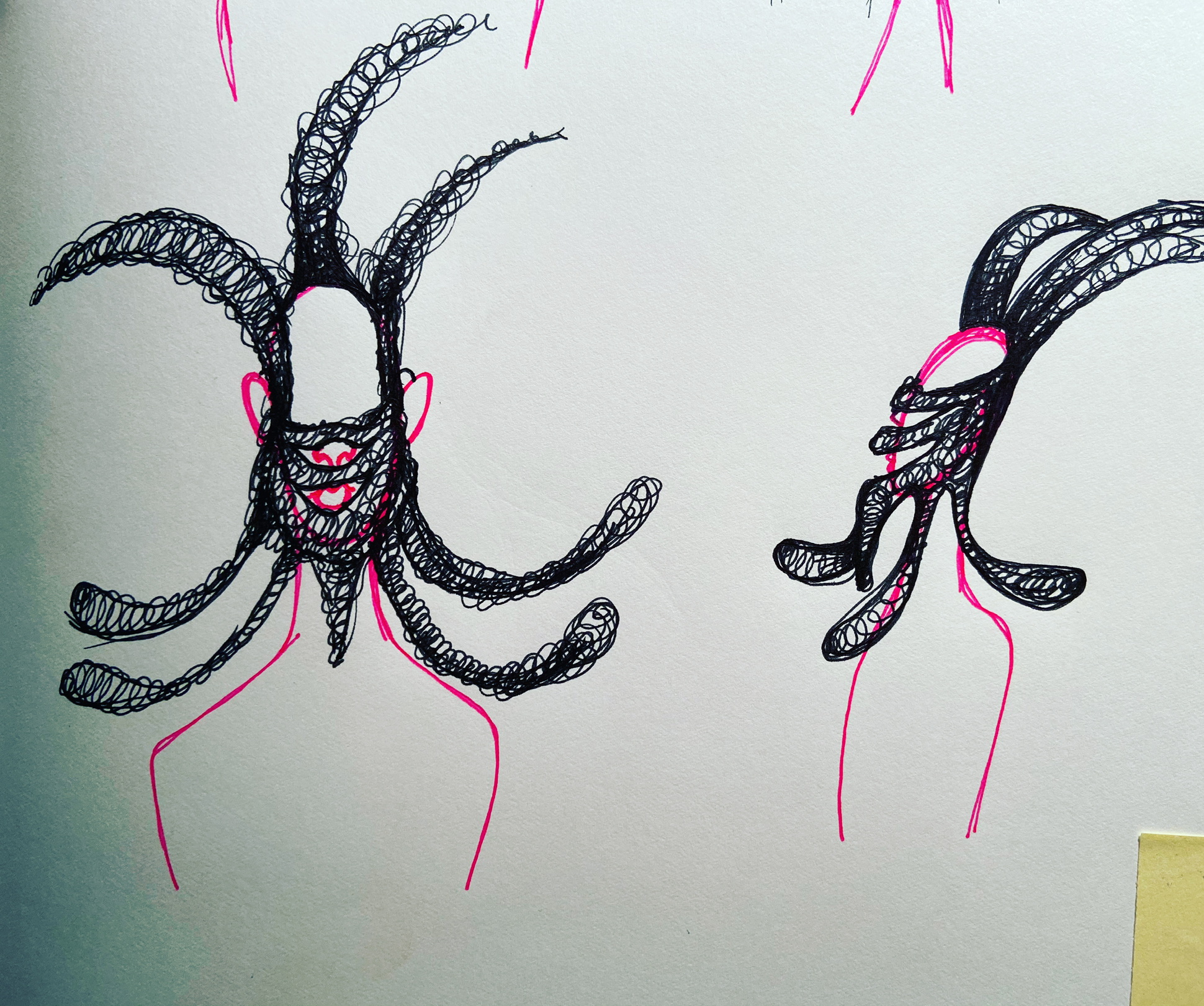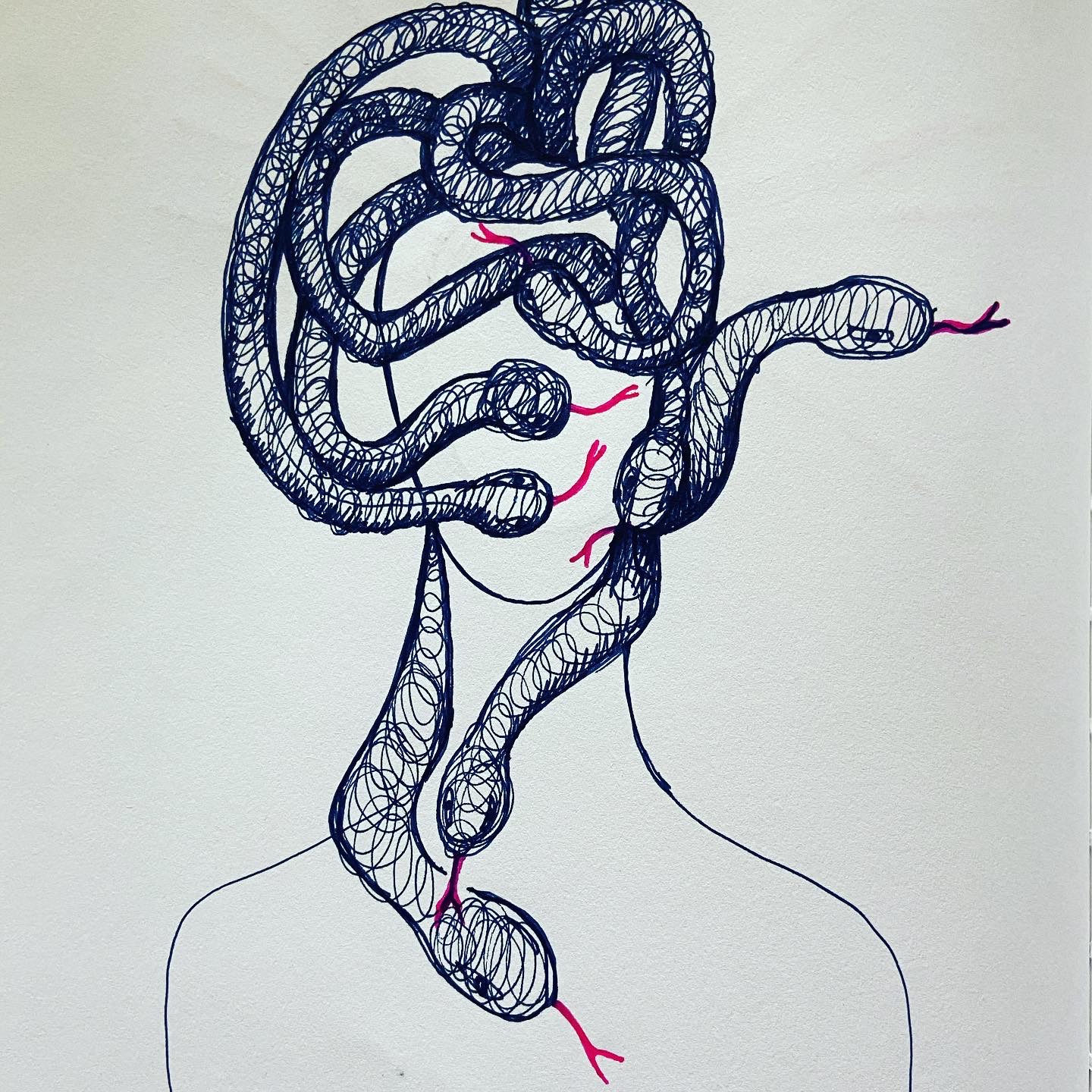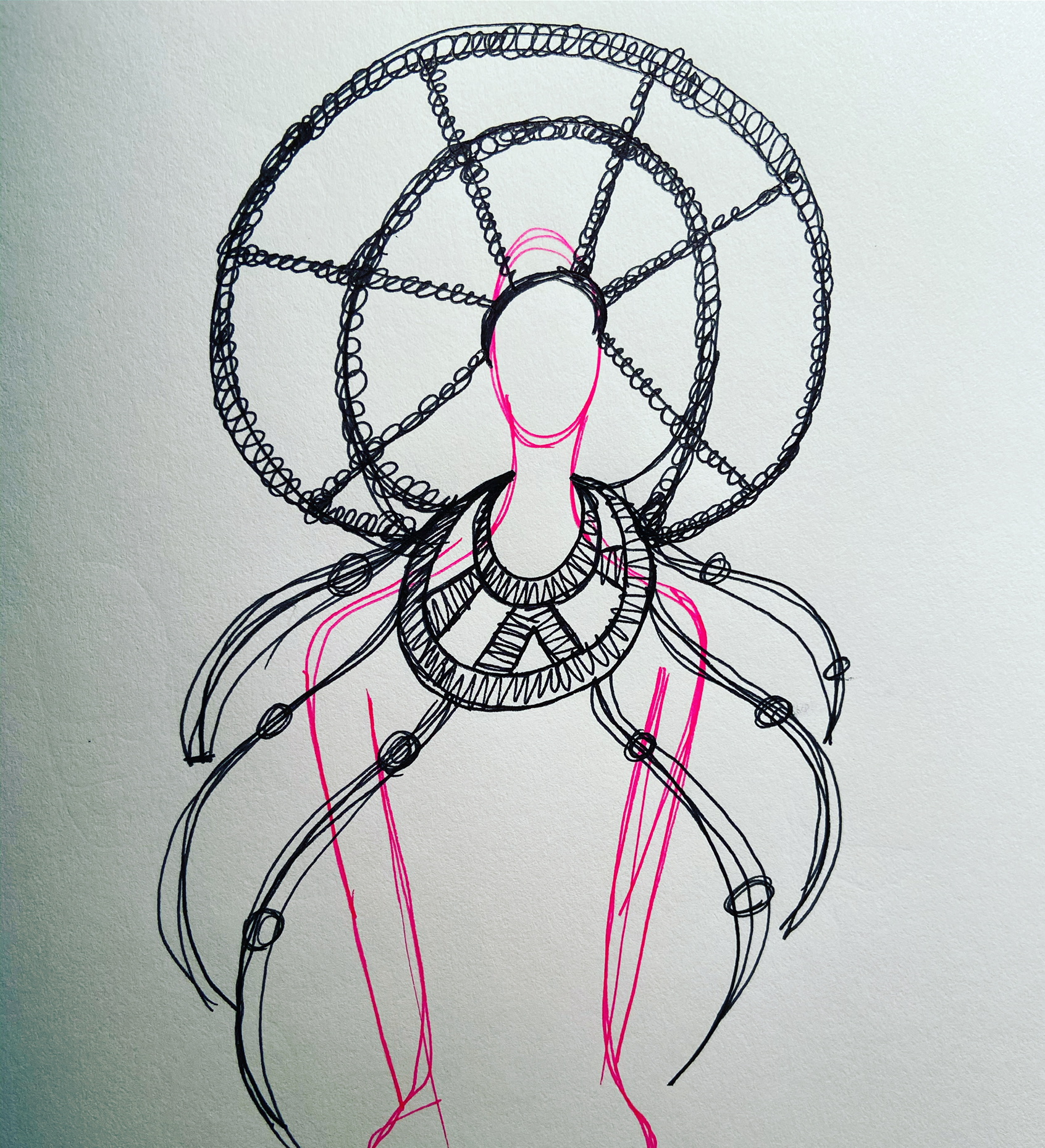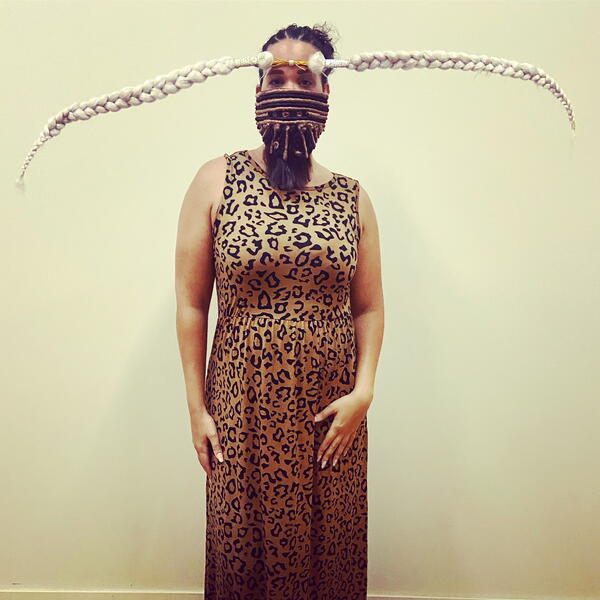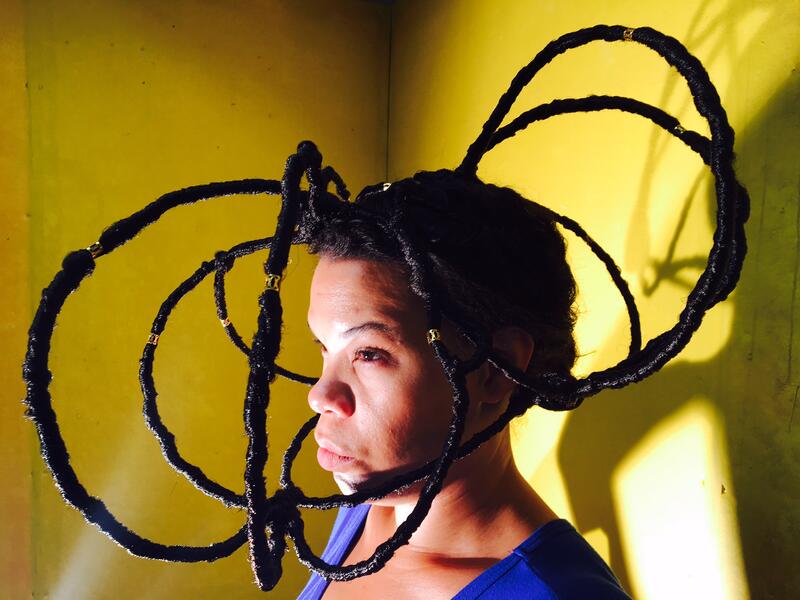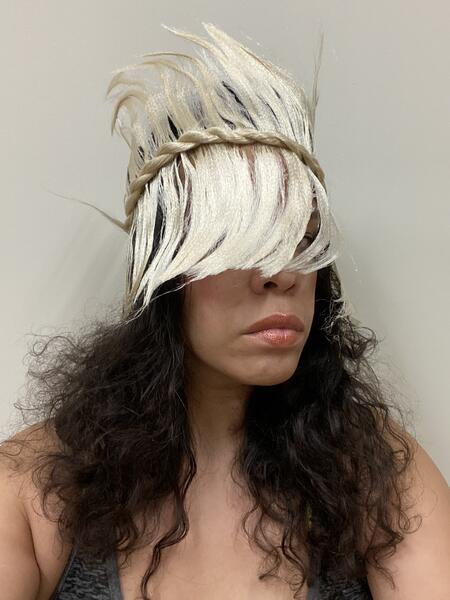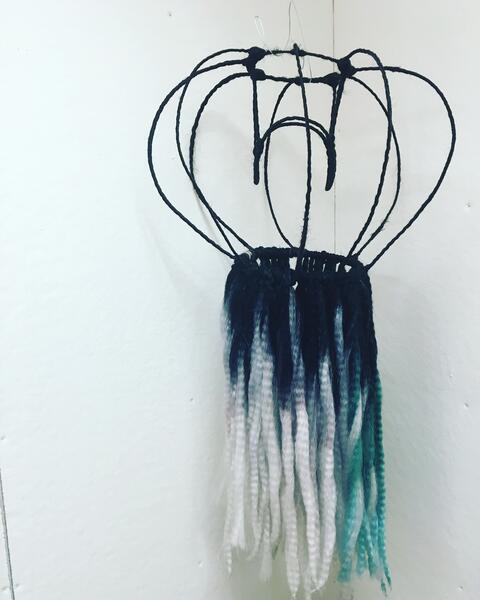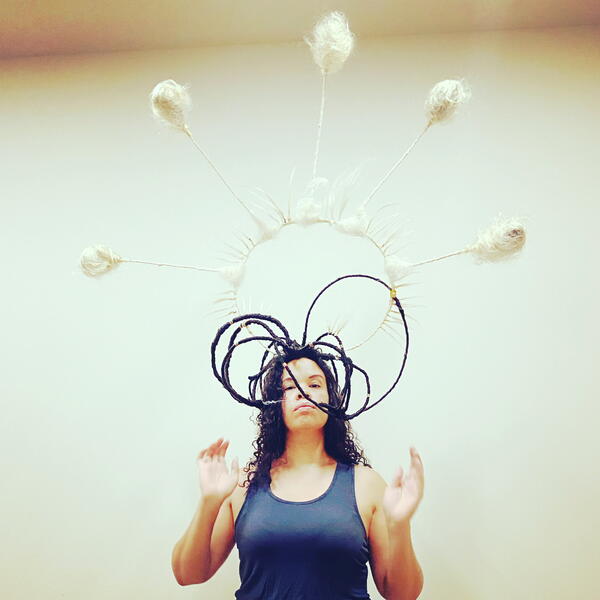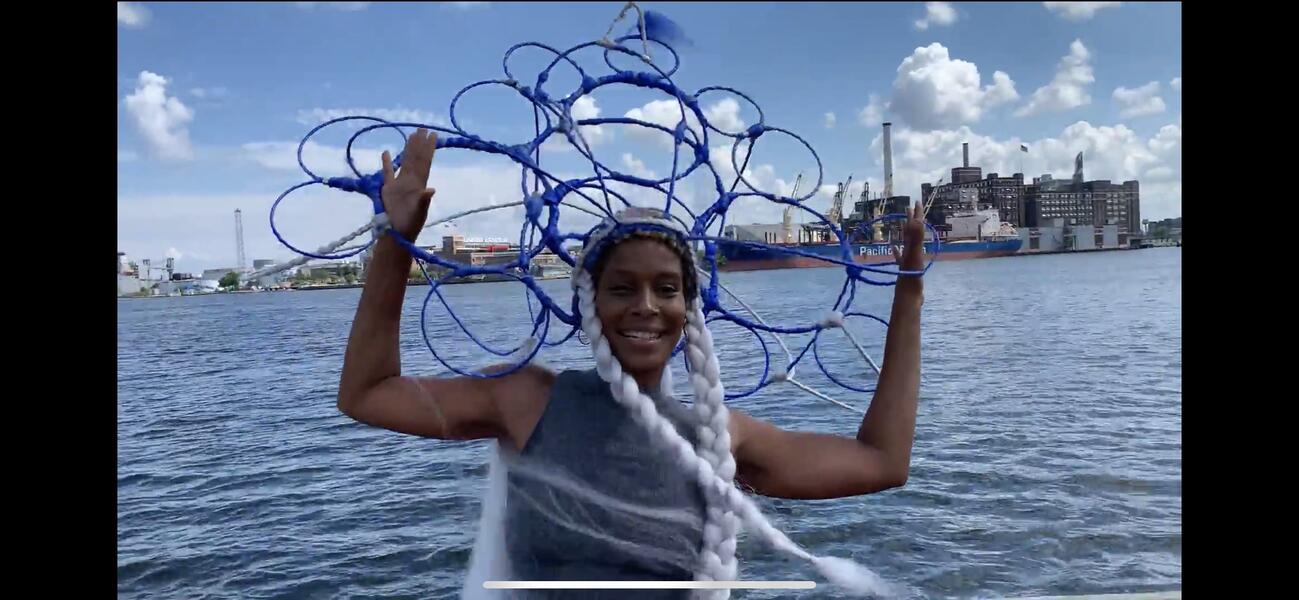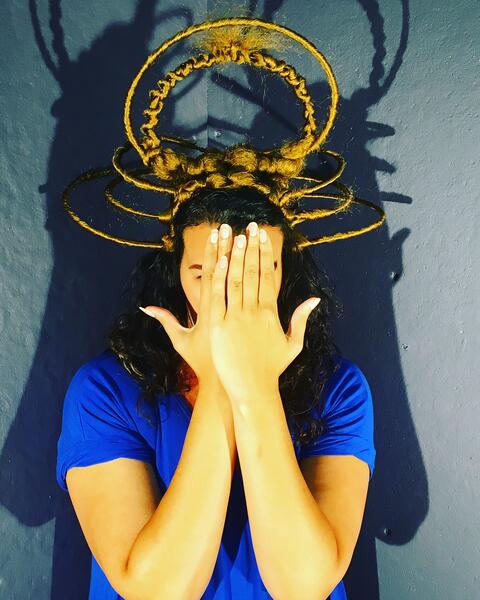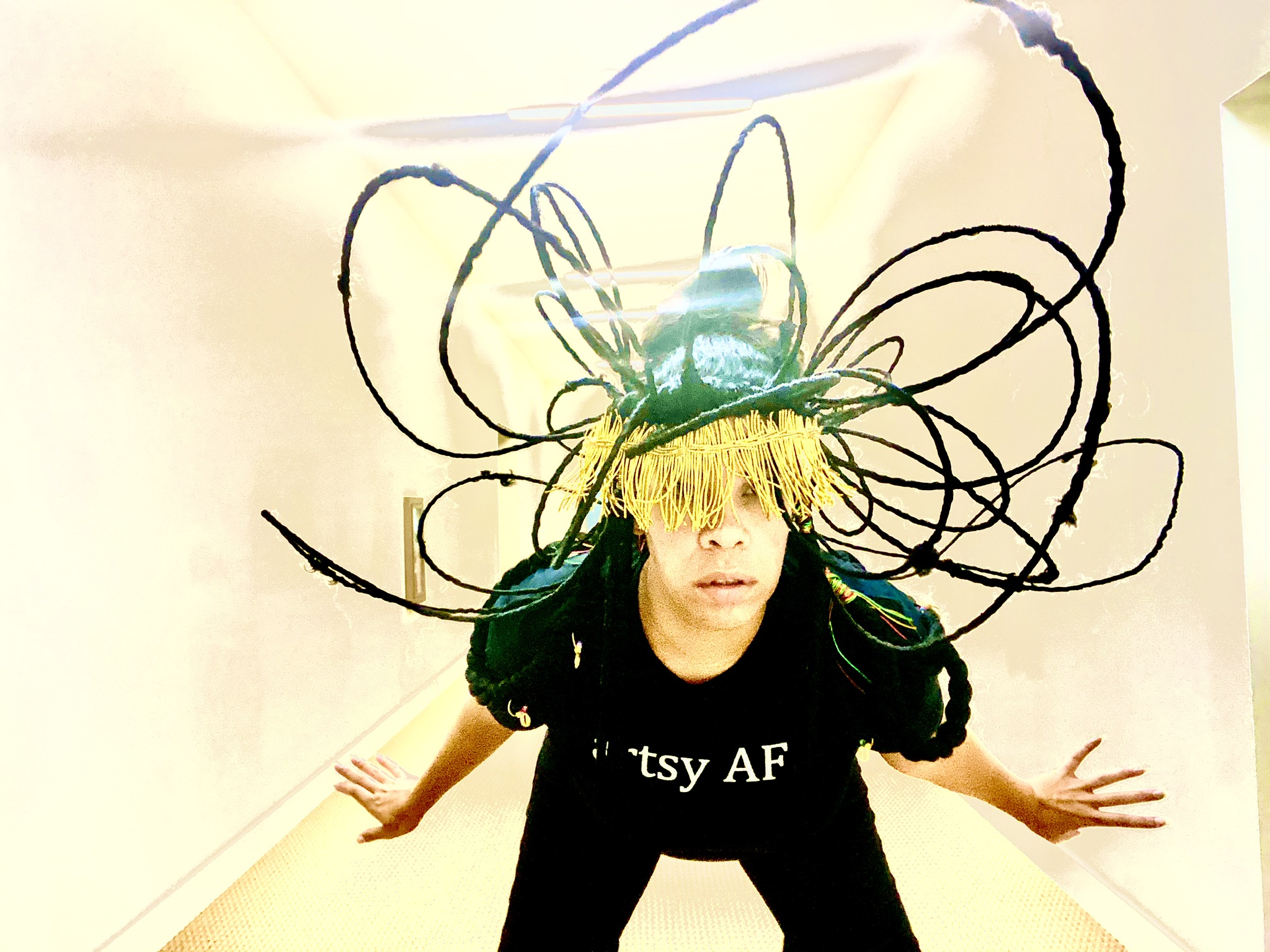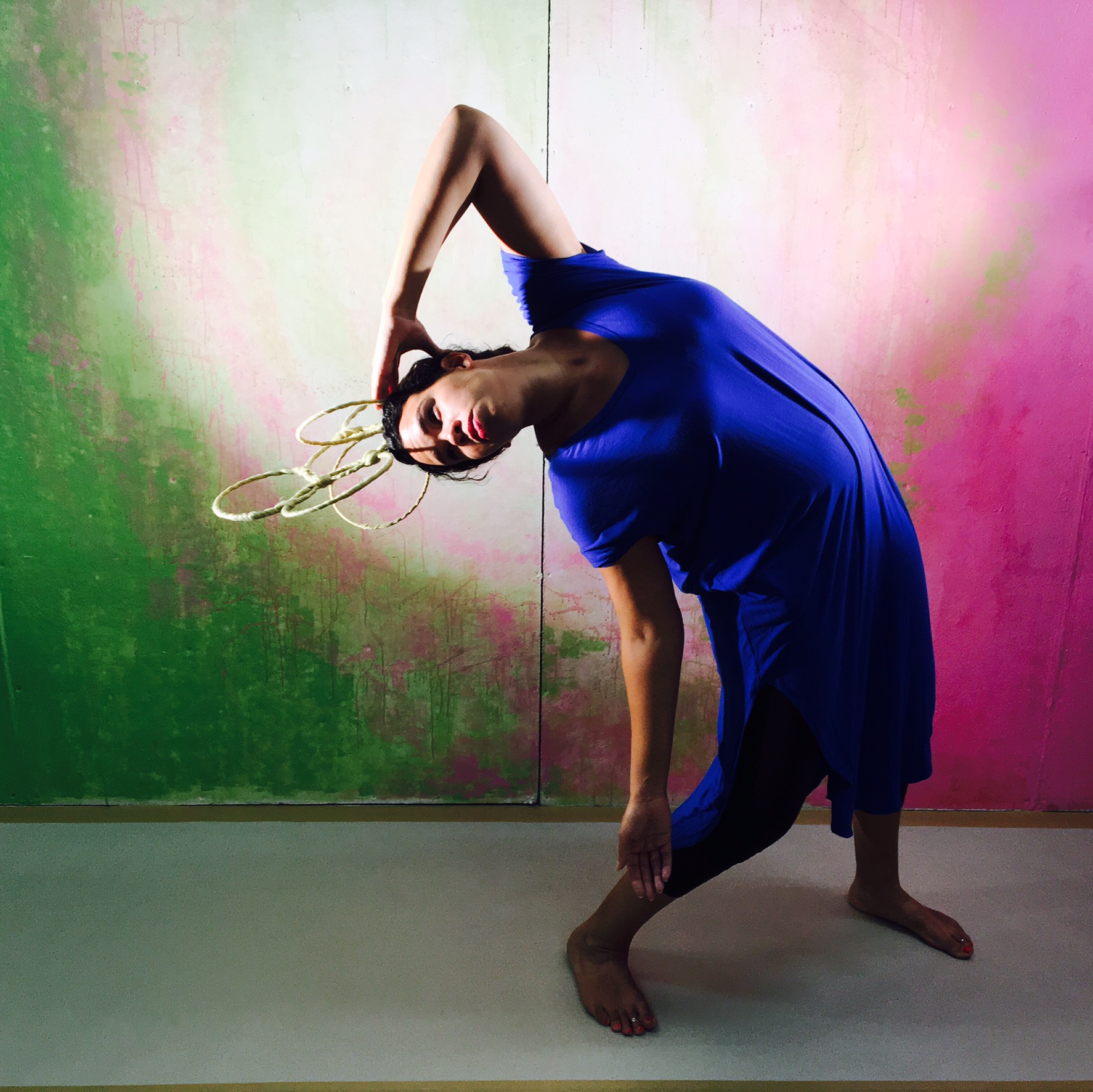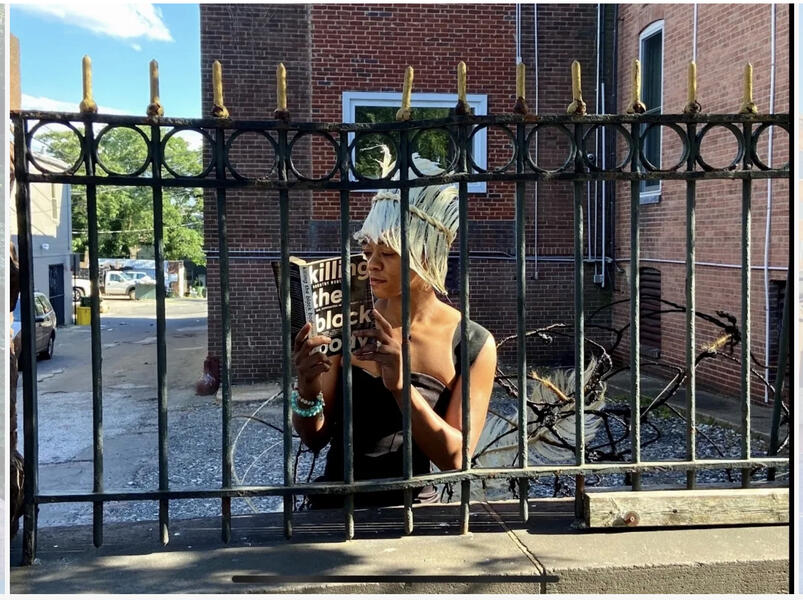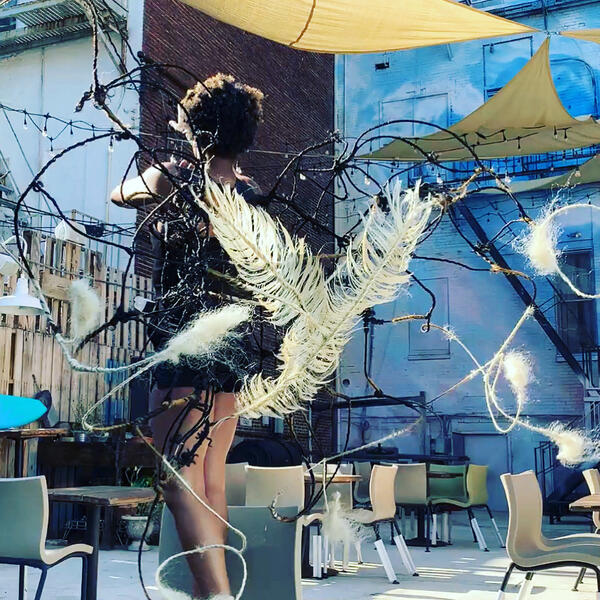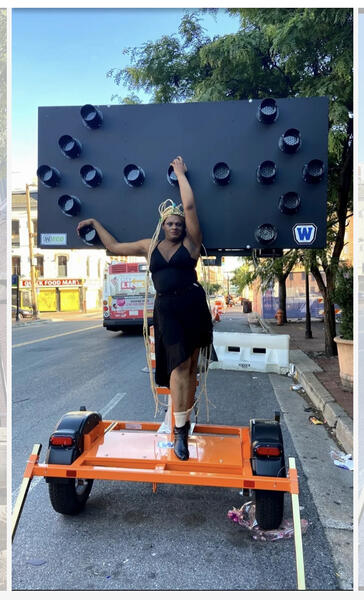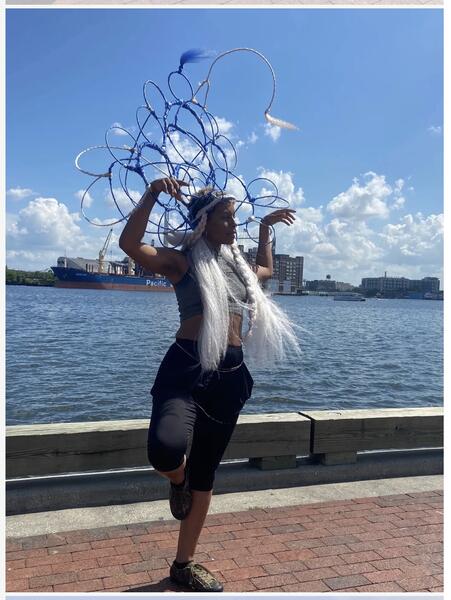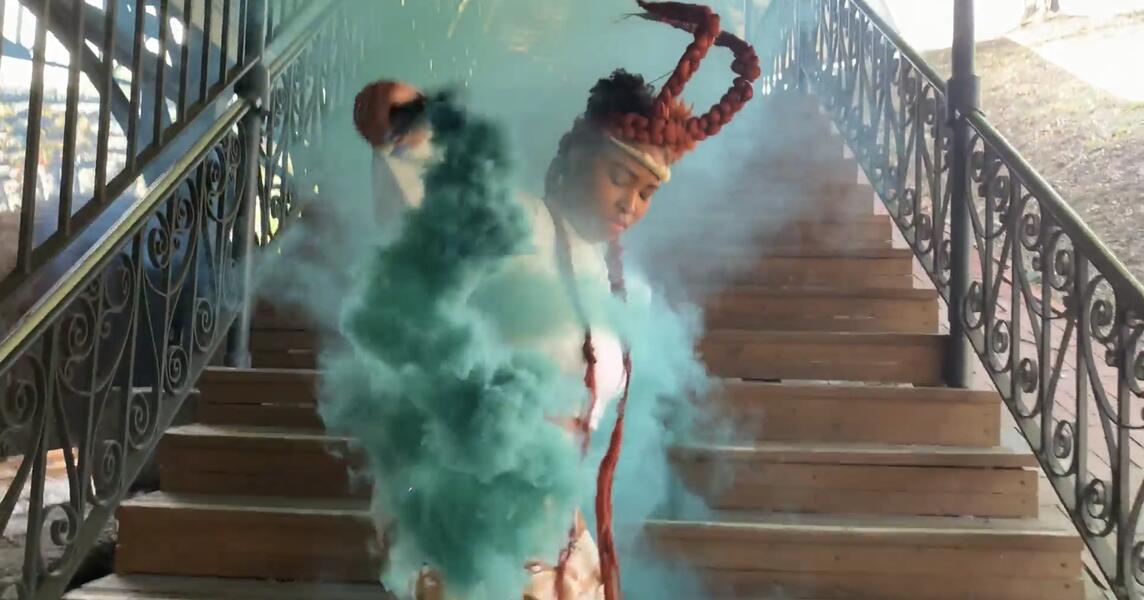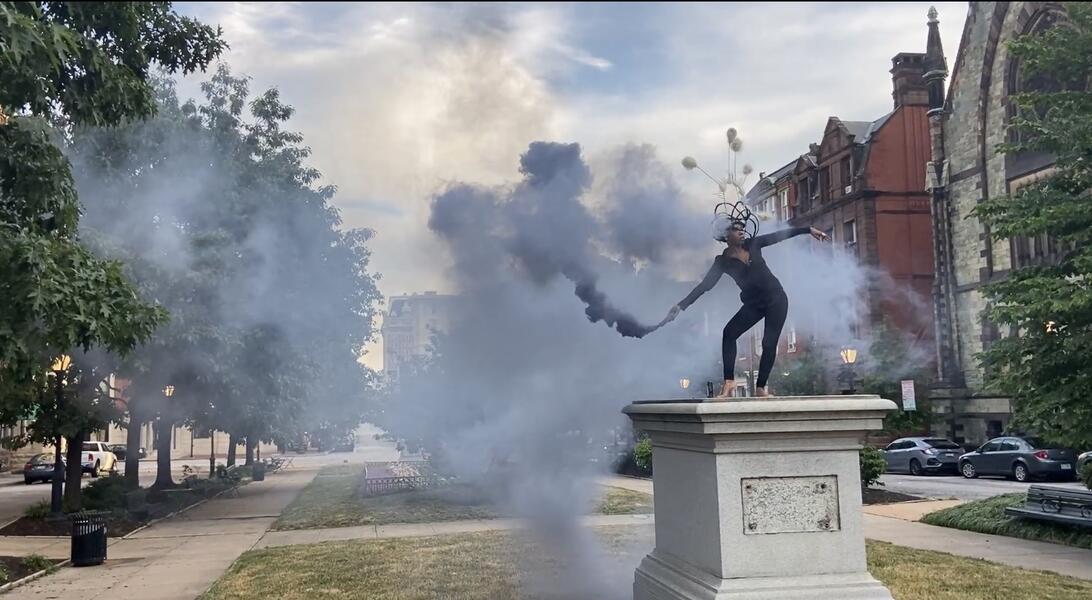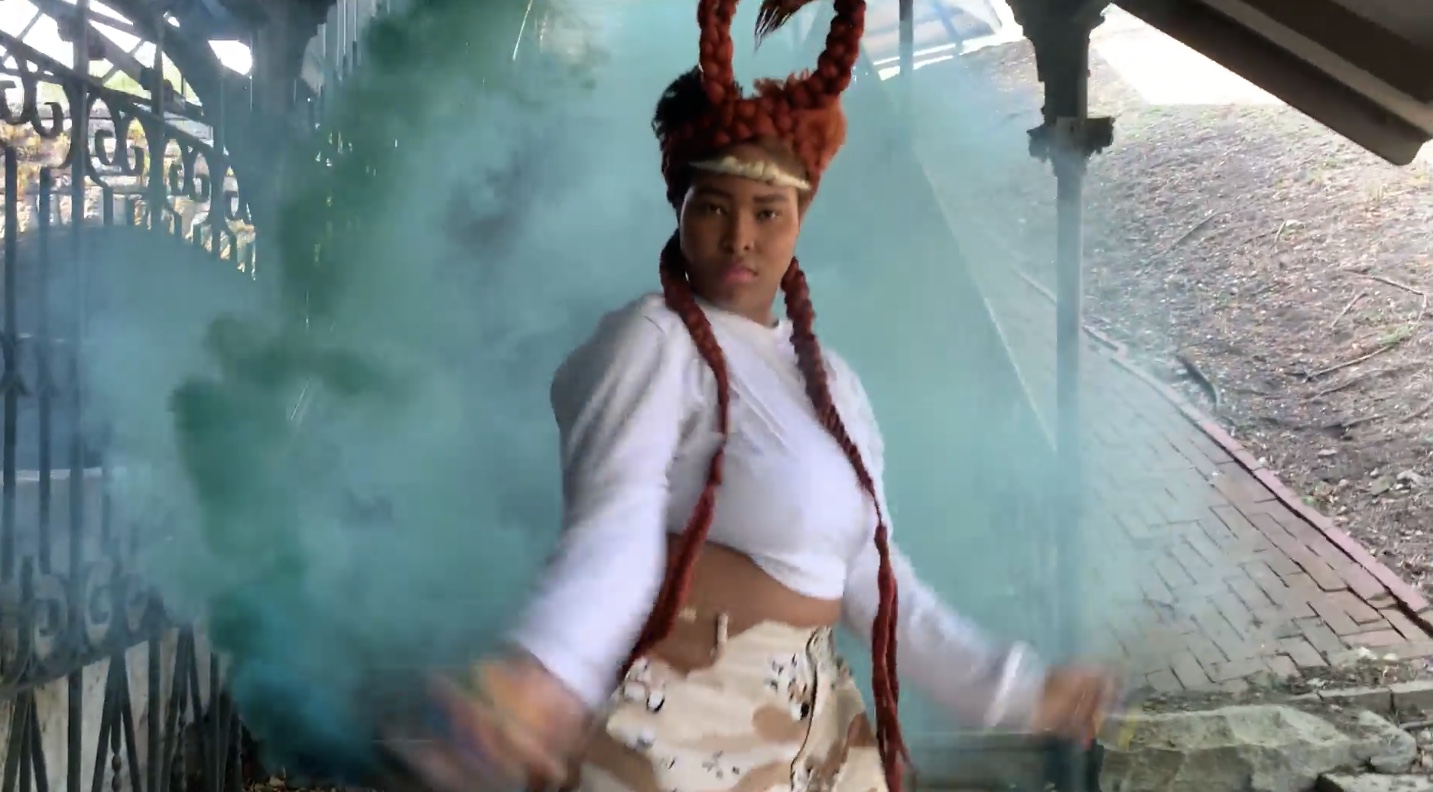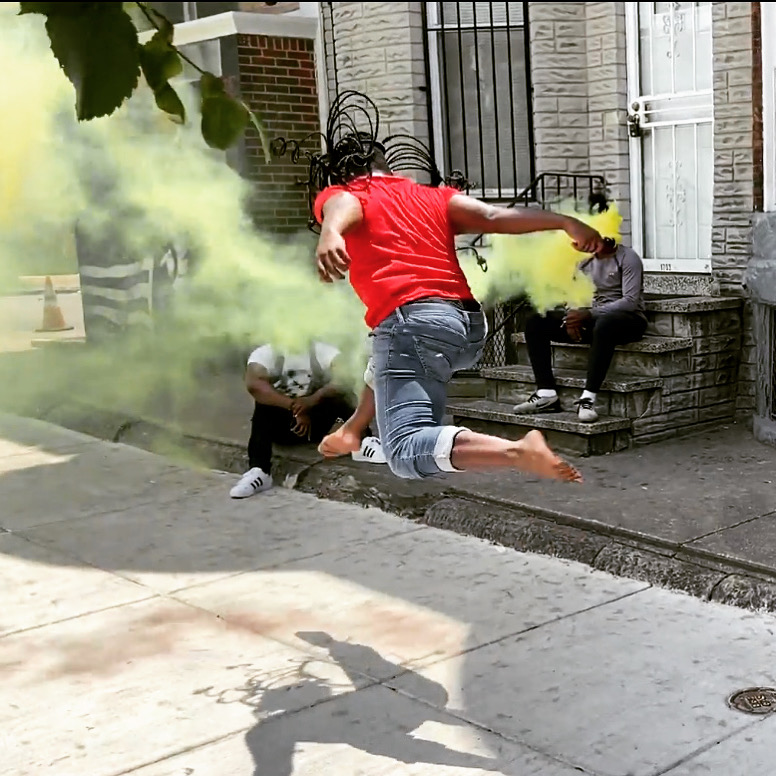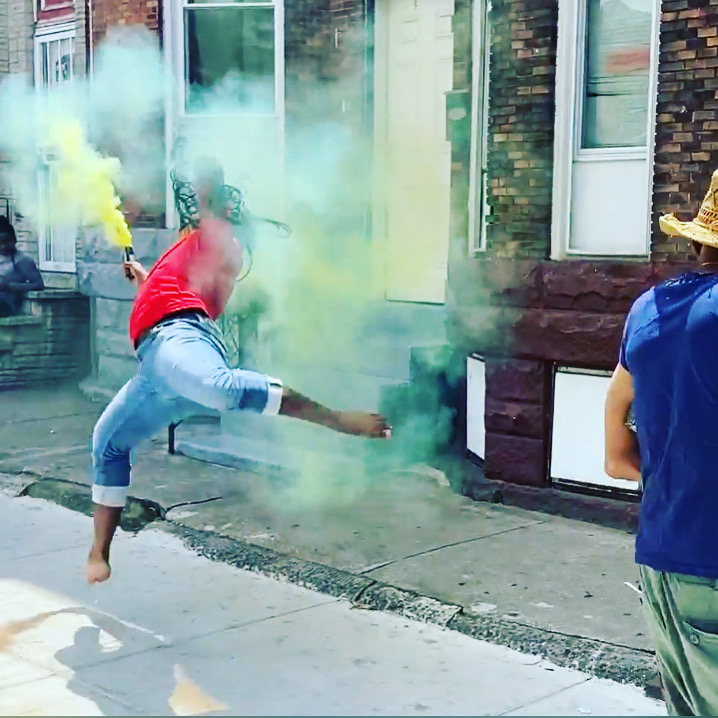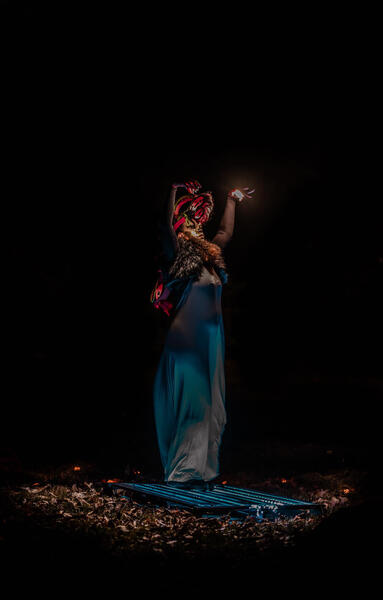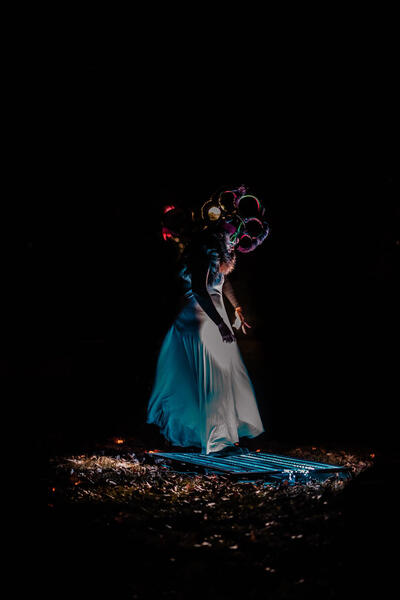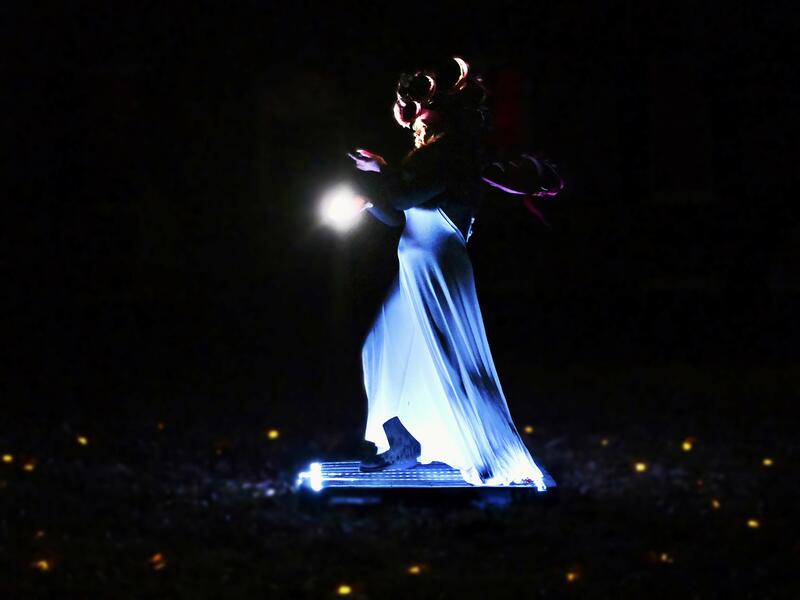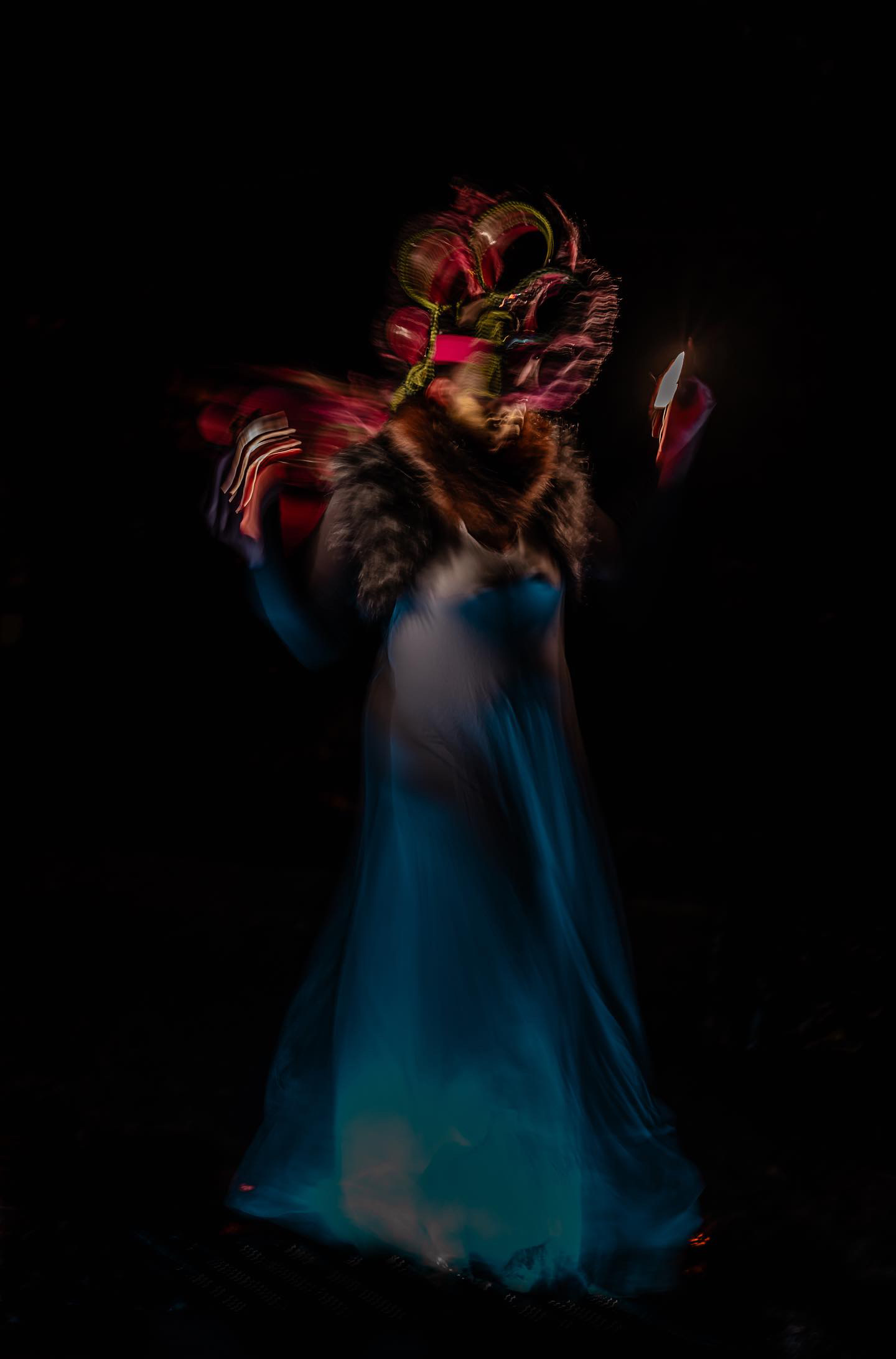Work samples
-
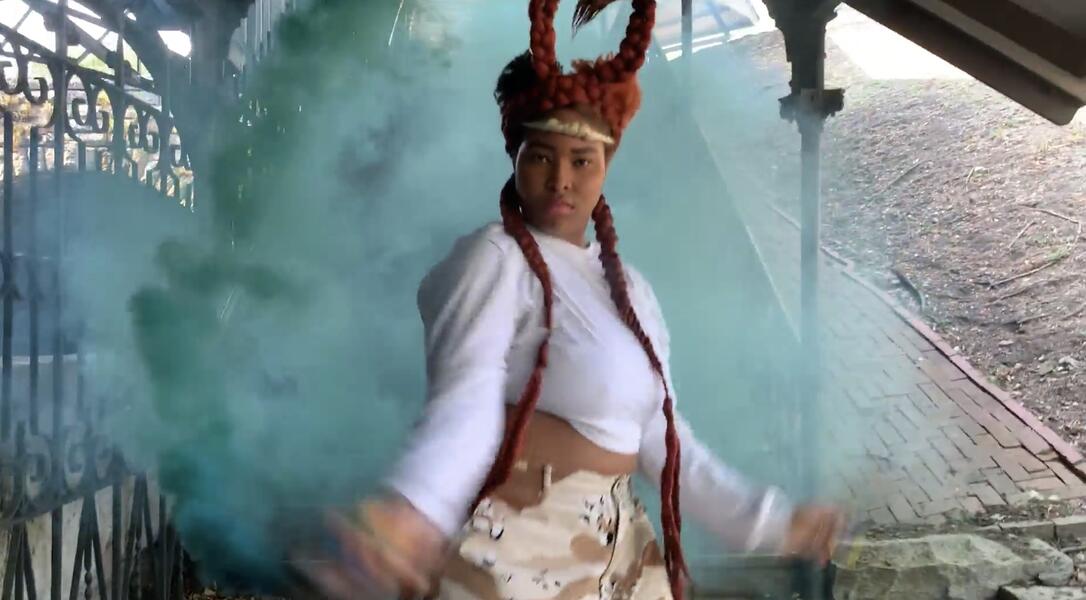 Dev’nay KessDev’nay cleansed the geography of the railroad in the film ‘UBUNTU’. The railroad was started in large part as a response to the demand to move black bodies inland expeditiously. This would extend the reach of the free labor of black slaves across the United States, increasing the Trans-Atlantic slave trade demands exponentially.
Dev’nay KessDev’nay cleansed the geography of the railroad in the film ‘UBUNTU’. The railroad was started in large part as a response to the demand to move black bodies inland expeditiously. This would extend the reach of the free labor of black slaves across the United States, increasing the Trans-Atlantic slave trade demands exponentially. -
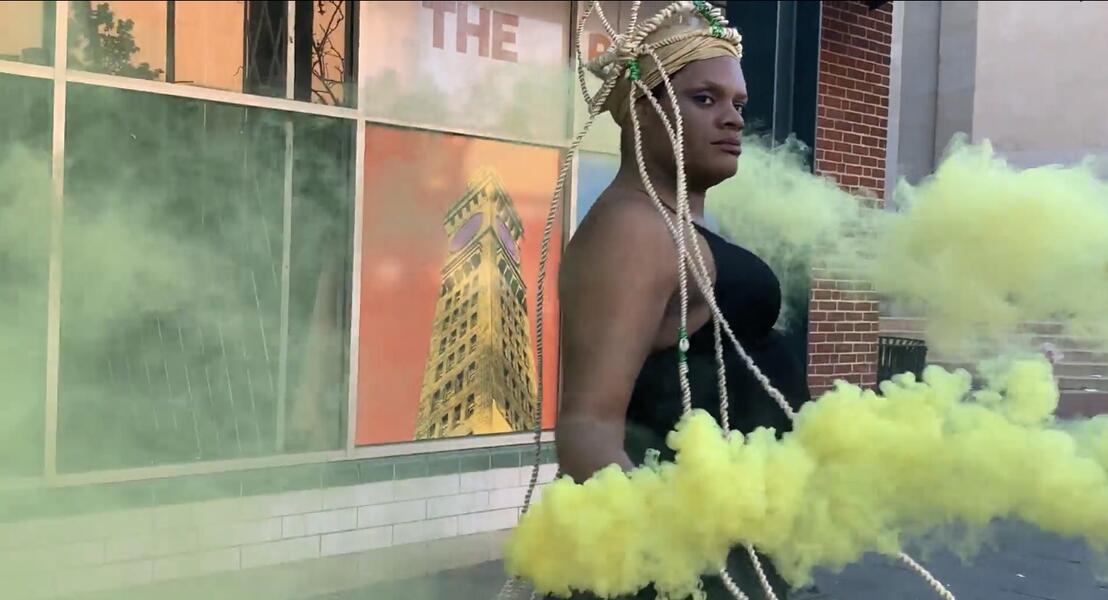 KarmaKarma was our trans performer who cleansed the slave auction site of Lexington Market. This site was one of the largest open air markets on the east coast. Slaves would be marched straight off of the slave ships and to Lexington Market to be sold on auction blocks next to the butchers and farmers selling their wares.
KarmaKarma was our trans performer who cleansed the slave auction site of Lexington Market. This site was one of the largest open air markets on the east coast. Slaves would be marched straight off of the slave ships and to Lexington Market to be sold on auction blocks next to the butchers and farmers selling their wares.
About Elizabeth
Sculptural Hair Paintings
Mythology and Folklore with afro-diasporic representation is the basis of Liz Miller's sculptural painting explorations. Much of our world is saturated with the default of the white body representing many deities and entities in physical format. Liz has been seeking to diversify the imagery associated with mythological, religious and folk stories. Beginning with the zodiac signs and expanding to an Afro-greek series, mermaids, Mami Wata and then the Orishas, Liz has been able to use her canvas as another way of storytelling research.
-
Scorpio
Scorpio zodiac sign personfied into celestial blackness.
-
Sagittarius
The sign of Sagittarius personified into celestial blackness.
-
Leo
personifcation of the Leo zodiac sign into celestial blackness.
Available for PurchasePrice upon request [email protected]
-
Aquarius
The personification of Aquarius into celestial blackness.
-
Capricorn
Capricorn personified into celestial blackness.
-
Pisces
Pisces is modeled after the zodiac sign. Here it is portrayed as a black mermaid.
-
Gemini
Gemini is part of the black zodiac series by Liz Miller. Highlighting the properties of the sign of the Gemini.
-
Taurus
Taurus is personifying the zodiac sign into figurative presentation. This piece pulled in the symbol which pulls from the constellations and stands for this sign. This piece shows 'bantu knots' which is distinctly different from any of the other paintings in this series. This was painted with black mirror paint designed by culture hustle and stuart semple. The largest piece in the series and the first to sell. Each piece is sold to someone of that zodiac sign, except Pisces.
-
Libra
Libra is personifying the zodiac sign into figurative presentation. This piece pulled in the symbol which pulls from the constellations and stands for this sign. The dreadlocks extend further out from the canvas from any of the other paintings. This was painted with black mirror paint designed by culture hustle and stuart semple.
-
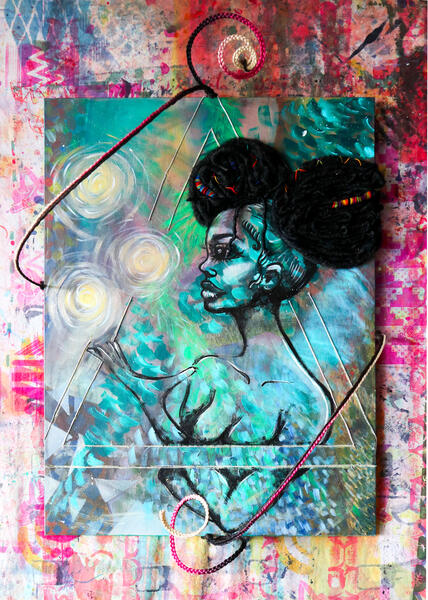 Aries
AriesAries is from my first series about personifying each of the signs of the zodiac into black celestial beings. I explored using paint which was unapologetically black, meaning it was designed to be the blackest black paint available. Each of the paintings in this series was sold to someone who was born under this sign.
Hair Garden
Anchor Points
The theme of my installation Anchor Points is “membership,” particularly as that concept applies to cultural groups. What qualifies one for initiation? Is it by birth alone, or can one be inducted by adopting specific roles and customs; and, if the latter, does that member ever truly "fit in"? What dues must be paid? Can elders be questioned? Is seniority relevant in relation to one's membership status? Anchor Points creates an imposing array of traversable webs spanning floor to ceiling. Visitors will question whether they have permission to step within the artistic perimeter. Their decision to engage the work, in fact, is a vital part of the piece. When we approach artifacts related to groups to which we do not belong to, do we question or honor perceived boundaries? What language can I as an outsider employ in comparison to the language they use amongst themselves? This concept continues on through many touch points.
This installation is two-fold: after the viewer is challenged to enter the installation's inner-space, the adventurous ones will encounter word phrases embroidered in the center pieces of the hair webs. These phrases, which are meant to be anchor points, are familiar to the artist's upbringing in the African-American community. To be a person of color in America is to embody many attributes of membership. Each web evinces the feeling of being stretched to its limits, but the phrase at the center has the power to reaffirm the person at his or her core. For instance, each phrase is taken from a different pillar of the African-American community. For example, "You might be a black Bill Gates in the making" is a quote from Beyonce's song Formation. Other phrases are taken from the film Black Panther, a gospel song by Israel Houghton, the African-American national anthem, and a quote from Maxine Waters. Each is intended to serve as grounding phrase which might empower an African-American. Music, faith, politics, and cinema are all major spheres in which African-Americans from various upbringings and classes unite around.
This piece may be accompanied by a performance art piece in which the artist engages the audience and asks them if they felt they had “permission" to enter the space. When questioning one’s own membership, one is compelled to ask what constrained or challenges the viewer about their right to participate and how this directly relates to membership to various groups that we interact in everyday. Whether that be class, culture, age, or interest- these groups have rules, dues, obligations, and benefits.
-
blackbillgatescloseup.JPG
-
blackpanthercloseup.JPG
-
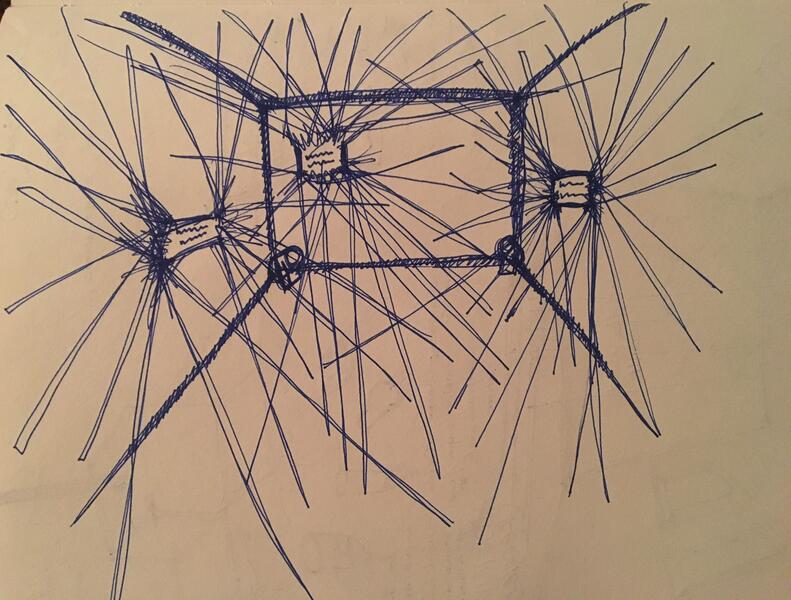 Installation plan sketch
Installation plan sketch -
anchor points instllation 4.JPGWide view of the web anchor points installation.
-
anchorpointsinstallation2.JPG
-
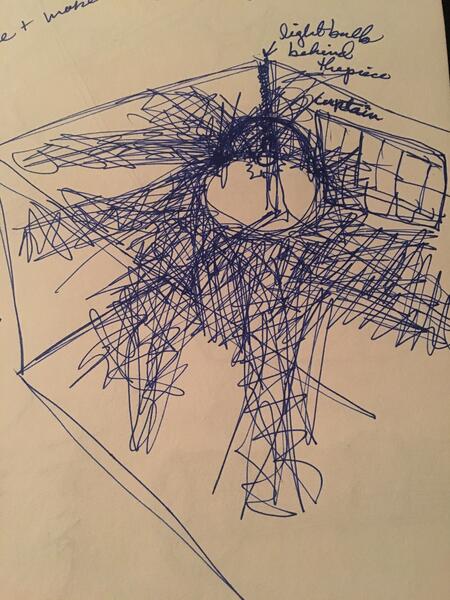 Hair Cave Installation Sketch
Hair Cave Installation Sketch -
Embedded rich media on Instagram
-
Digital embroidery on hairProcess video of digital embroidery on hair.
-
digital embroidery on hairProcess video of digital embroidery on anchor points.
-
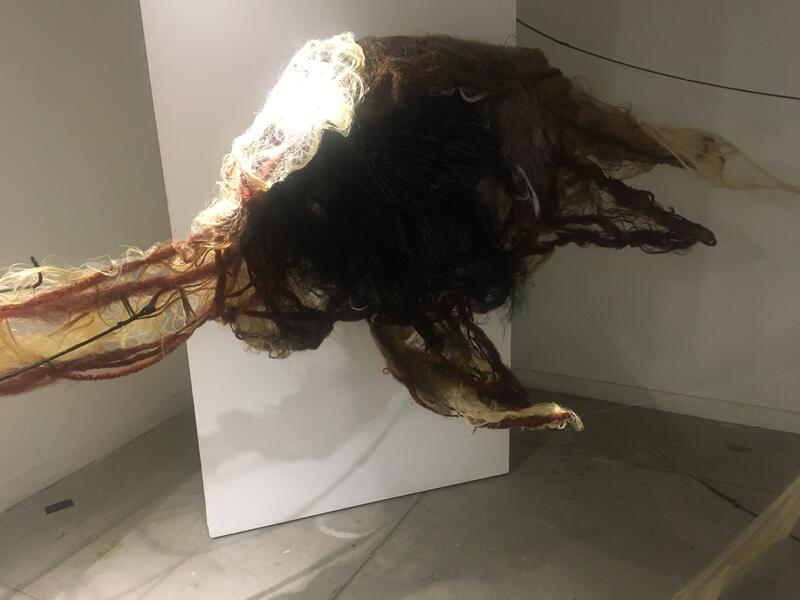 Hair Cave
Hair Cave
You are Hair
within it. African American hair styles and designs have enjoyed a rich,
multi-hemispheric tradition spanning centuries that are both the product of
and a response to the systemic racism and atrocities which African-
Americans and their ancestors are all too well acquainted. Hair techniques
and treatments have been a slow-developing industry, often employed not only to
make black hair more manageable but more like the “Caucasian ideal.”
Many African-Americans have warm memories of hair braiding at home,
with relatives, or at the salon. The wig shop and beauty store are staple
locations evocative of identity and opportunity. Nevertheless, the hair
that one can “afford” and the styles chosen are symbols of class. To
braid and integrate fake hair are valued skill sets. We are beyond the boom
of chemical perms, with current styles being braids and crochets. African-
American hair color, texture, and style, no matter the cost, are distinctly
self-expressions of identity, especially for those who are economically
struggling.
News coverage has accurately reported how societal rules
disproportionately restrict black hair care choices in the workplace. In
many cases we see outright discrimination, especially in regards to
dreadlocks in corporate environments or the military. In a recent lawsuit
against Hooters, an African-American woman prevailed after being fired for
dyeing her hair a color that differed from its natural hue, when Caucasian
co-workers had not been held to the same standard.
The work explores the connection between African roots and
the contemporary United States. African textile patterning serves as inspiration for
the wire headdresses wrapped in synthetic hair and thread. To amplify this
follicular celebration, the hair is used in a domestic fashion appearing on furniture
and modeling familiar structures like windows and carpets. Pausing
before the work, the viewer becomes part of it. Based on the observer’s
ethnicity, he or she may engage in small-scale cultural appropriation
simply by viewing the work or participating by trying on the headdresses in
front of the mirror. This initiates a conversation with the audience in
with respect to the question of whose cultural traditions belong to whom.
Hopefully viewers will engage the question of how to be more celebratory of
our differences in culture without appropriating them.
This collection/installation is titled 'You are Hair'. This explores the concept of home by displaying ready-made home goods adorned or covered with hair. Home is intrinsic to the black experience of 'getting their hair done'. Hair is often done by family members in home. This private affair is unique in variety from family to family, but has many things in common of course, from hair to technique, to body position and trendy adorning elastics and charms. These home goods are stand-ins for the bodies who participate in their traditions. The actual individual parts of this daily and weekly ritual has evolved over the years. This is due in part to discoveries of the damaging effects of chemical treatments, the natural hair movement and protective styles.
List of Objects:
Hair Lamp: 8” x 24”
Hair Chair: 18” x 36”
Table: 20” x 30”
Red dreadlock wall piece: 16” x 20”
White and black wall piece: 18” x 25”
Head piece blond: 8” x 14”
Head piece brown: 8” x 12”
Headpiece black: 12” x 16”
Headpiece blueblack: 11” x 24”
Potpourri hair: 4”x 4”x 5”
Photo collection: 40 photos
Windowsill: 3” x 17”
Hair curtain: 8” x 14”
Braids for window: 5 measuring 25” each
Mirror: 17”x 24”
Jewelry triangular red dread/blue scarab earrings: 3”x3”
Jewelry blue scarab earrings/black dreadlock: 1”x8”
-
flavorofthemonth.JPGsynthetic hair, dyed and draped in ready made chair
-
lizwearingheaddressandglass.JPGLiz wearing headdress, dreadlock earrings, and glass of hair
-
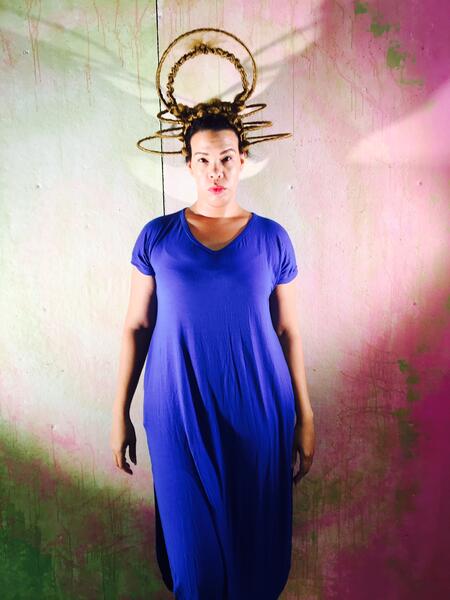 Brown Headdress
Brown Headdress -
 Blond headdress
Blond headdress -
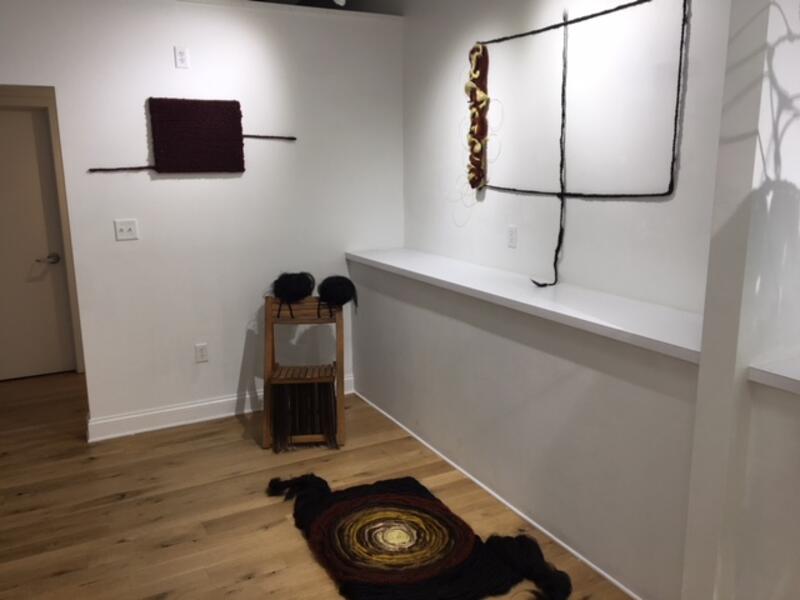 chair rug flag window.jpg
chair rug flag window.jpg -
 earrings.jpgscarab wire earrings with crochet dreads
earrings.jpgscarab wire earrings with crochet dreads -
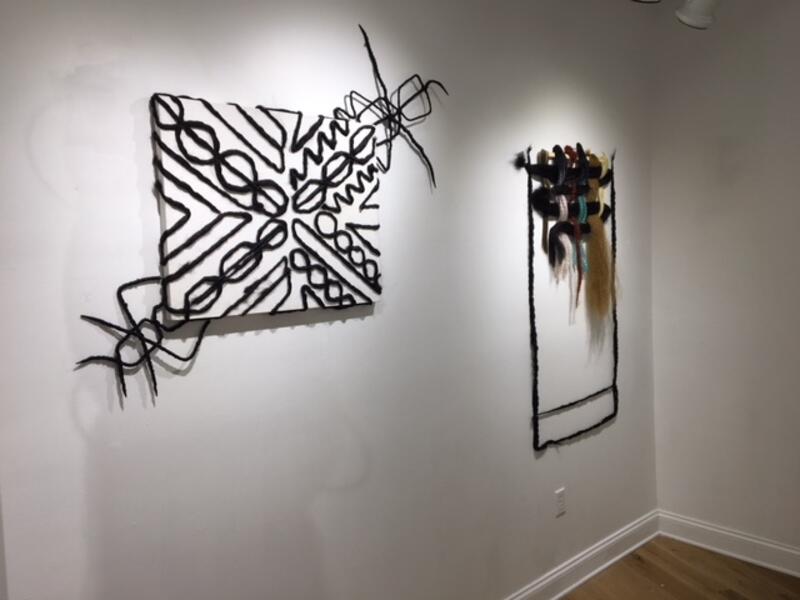 canvas and window.jpgbraid patterning canvas and hair curtain window of braids.
canvas and window.jpgbraid patterning canvas and hair curtain window of braids. -
cageheaddress.JPG
-
closeup of buttheaddress.JPGClose-up of butt & thighs headdress/ wall piece.
-
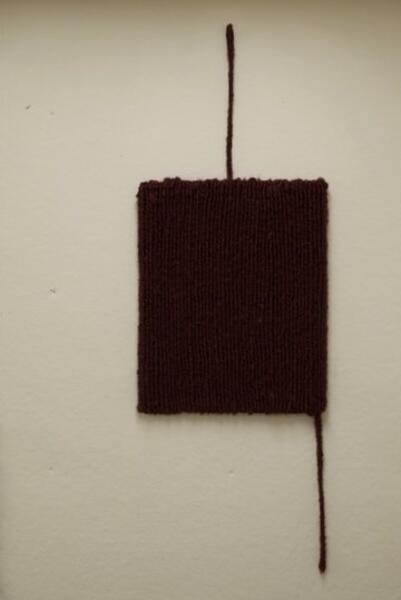 Osaycanyoudread.jpeg
Osaycanyoudread.jpeg
Hair Headdress Sketches
UBUNTU film
This film is a collection of 6 performers transforming spaces with significant ties to slavery or present day racism in the city of Baltimore, MD. While they perform movement in these spaces, their black bodies are adorned with wearable hair art sculptures which function as sacred objects. The use of smoke is meant to tap into the energy of the ancestors who walked there while simultaneously attempting to push forward to an emancipated future. An emancipation which comes from unlocking what’s embedded with versus the traditional pathway of seeking freedom from the colonizer.
https://youtu.be/ltIKHMZ5sG8
Hays-Heighe House
In December of 2023, I performed a ritual cleansing ceremony at Harford Community College, at their historical site known as the 'Hays-Heighe House'. This was a recorded outdoor performance, which was staged behind the house after dark. I was illuminated through hand-held lights and a wood pallet made into a light-up stage (a product of my design). The soundtrack to my performance was my voice pre-recorded, speaking poetically about finding our feet, feeling grounding, and inviting participation in certain parts as well as telling the history of the site. At one point we imagined the names of the enslaved in this location. The 1860 census only listed the enslaved at this location by gender and age so the recording read each listing with allotted time to imagine a name for this individual who was on this very site 168 years ago. I used colored chalk, held in an abalone shell from a local body of water, and pinched some chalk into the air for each individual who was not allowed their personhood in 1860.
Surrounding the stage in the grass, are battery-operated votive candles, 1 for each of the 31 enslaved.
The Hays-Heighe House on the campus of Harford Community College was listed on the Underground Network as an 'escape site'. The sound art that I created telling the history of the site calls out this inaccurate way of writing about the site. The definition of the Underground Railroad Network is a series of safe houses that enslaved Africans used to escape to freedom. A site where 'enslaved africans' would run from and risk exposure, starvation, etc does not qualify a site for inclusion on the Underground Railroad.
This performance was documented and will be made into a film but is currently in progress. However the site has been documented through photographs, as seen here, by a Harford CC student named Mica and James Craig Photography.
Public Art - Saltboxes
-
 Tribute Saltbox
Tribute SaltboxThis saltbox design was a one-off. The community of HIghlandtown was shaken when Hoehn's Bakery was unexpectedly closed by the health dept. It could have been a temporary situation but the family decided to close their 3rd generation run business. However this business was beloved by the neighborhood so I decided to create this box, combining some imagery from a mural on the side of the bakery and updating it a little. This design was put onto a box 2 blocks away from the site of the closed bakery.
-
 Natty Shakur
Natty ShakurPart of the saltbox series reimagining Natty Boh to be more relevant to Baltimore. This design was placed 3 blocks from the house Tupac Shakur lived in while he was in Baltimore.
-
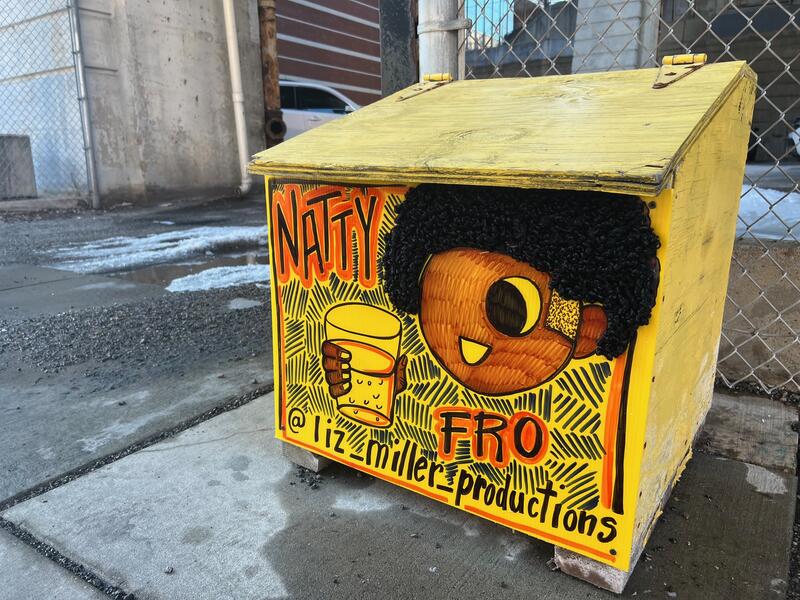 Natty Fro
Natty Froa design from 2023. borrowing the Natty Boh design and reimagining it for Baltimore.
-
 Dru Hill in Druid Hill Park
Dru Hill in Druid Hill ParkLiz was comissioned by the dept of transportation to create an original work of art for one of the giant saltboxes which would adorn our great parks in Baltimore.
-
 This is a Saltbox, not a Ballot Box: Issa Rae President Barbie
This is a Saltbox, not a Ballot Box: Issa Rae President BarbieThis box is part of the series 'This is a saltbox, not a ballot box.' It is about actually inspiring presidential nominations from Baltimore. Historical and present-day black examples of excellence.
-
 Cab Calloway
Cab CallowayThis box is part of the series 'This is a saltbox, not a ballot box.' It is about actually inspiring presidential nominations from Baltimore. Historical and present-day black examples of excellence.
-
This is a Saltbox, not a Ballot Box: Kevin Brown
Nomination of Kevin Brown of 'Nancy by Snac' to the role of POTUS.
-
This is a Saltbox, not a Ballot Box: FREDERICK DOUGLAS
Installed on a box near frederick douglass high school in baltimore.
-
This is a Saltbox, not a Ballot Box: BILLIE HOLIDAY
BILLIE HOLIDAY, installed near the beginning of Pennsylvania Ave to reference the Chitlin Circuit which every performer had to make their mark on to prove they had the chops in the music industry, but also right near U of MD hospital to link her intense health problems which led to her early death.
-
This is a Saltbox, not a Ballot Box: Chyno
This is Chyno, the blue bearded foodie, a local food blogger in Baltimore. This person has received nomination from Liz Miller to be put onto a saltbox. Installed on a saltbox near WBAL tv station in order to help celebrate 'Plate It' a new show he is featured on.
School for Colored Girls: DuPont Underground: DC
Synopsis
This film details the history of the area of DuPont Circle in Washington D.C. A site where a ‘School for Colored Girls‘ was founded by the white female abolitionist, Myrtilla Miner. She began teaching 6 black girls to read in a time when it was still illegal to teach the children of enslaved africans. In two months, she had 30 pupils. Over the years she would need to move her school from place to place for safety, but it all began here in DuPont Circle. Her students would eventually become teachers who would train other teachers. This legacy of literacy and equality is what Myrtilla Miner leaves behind.
Details about the Original Live Performance
The film was made using footage of the original live performance recorded on 3/3/23. This performance was a part of the opening reception of the exhibition ‘Cost of Living’, about the resilience of black women. The exhibit was the highest-attended exhibit ever for the Dupont Underground, located at 19 DuPont Circle, Washington D.C. Curated by Nikki Brooks.
-
Performance Image 6
This image is from the moment when the stage turns off at the end of the performance, immediately before I step down. the backlight created an amazing effect that I have not seen since.
-
Performance Image 5
After deploying the chalk to bless the space, the light bounces off of the chalk creating a diffusion in the photography. This performance element is meant to portray the moment when the energy shifts in the space for those who are not attuned to those changes.
-
Performance Image 4
Mid- performance doing a back bend, lit only from the base of the stage during performance in a subway tunnel.
-
Performance Image 3
This image was taken during the procession to the stage before the audio began to tell the story of the space that we were in.
-
Performance Image 2
This performance began with lights in the hands and the stage lit up and slowly grew to turning off the hand lights and turning on the headress. then utilizing the chalk as we came to the ritual blessing of the space.
-
Performance Still 1
Liz Miller staged on her home-made stage with home-made light-up headdress, healing garment (made by local designer out of bamboo- which has healing properties) in the DuPont Underground Art Space in DC which is geographically below DuPont Circle.
-
Work in Progress Film
Audio is being replaced soon with added footage.

